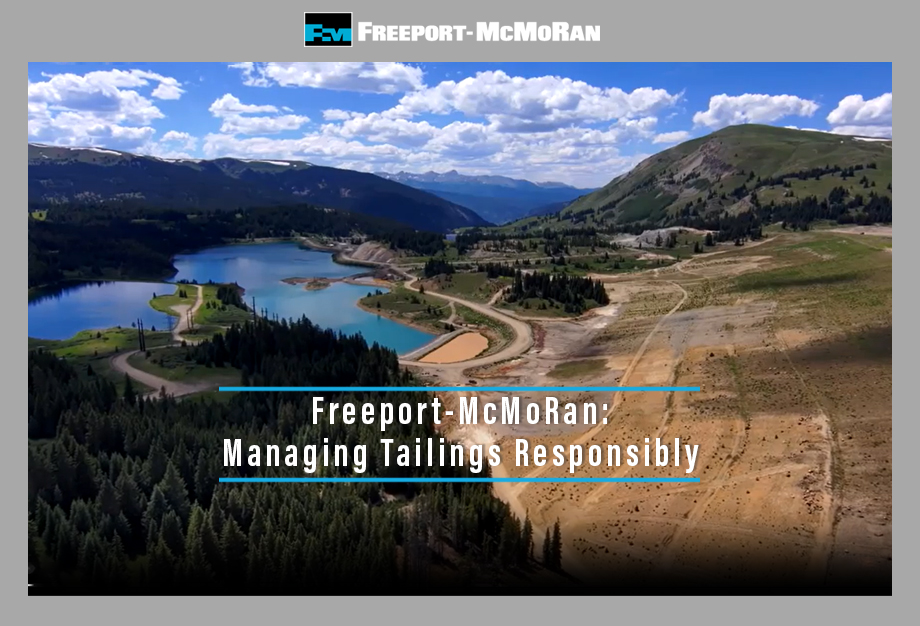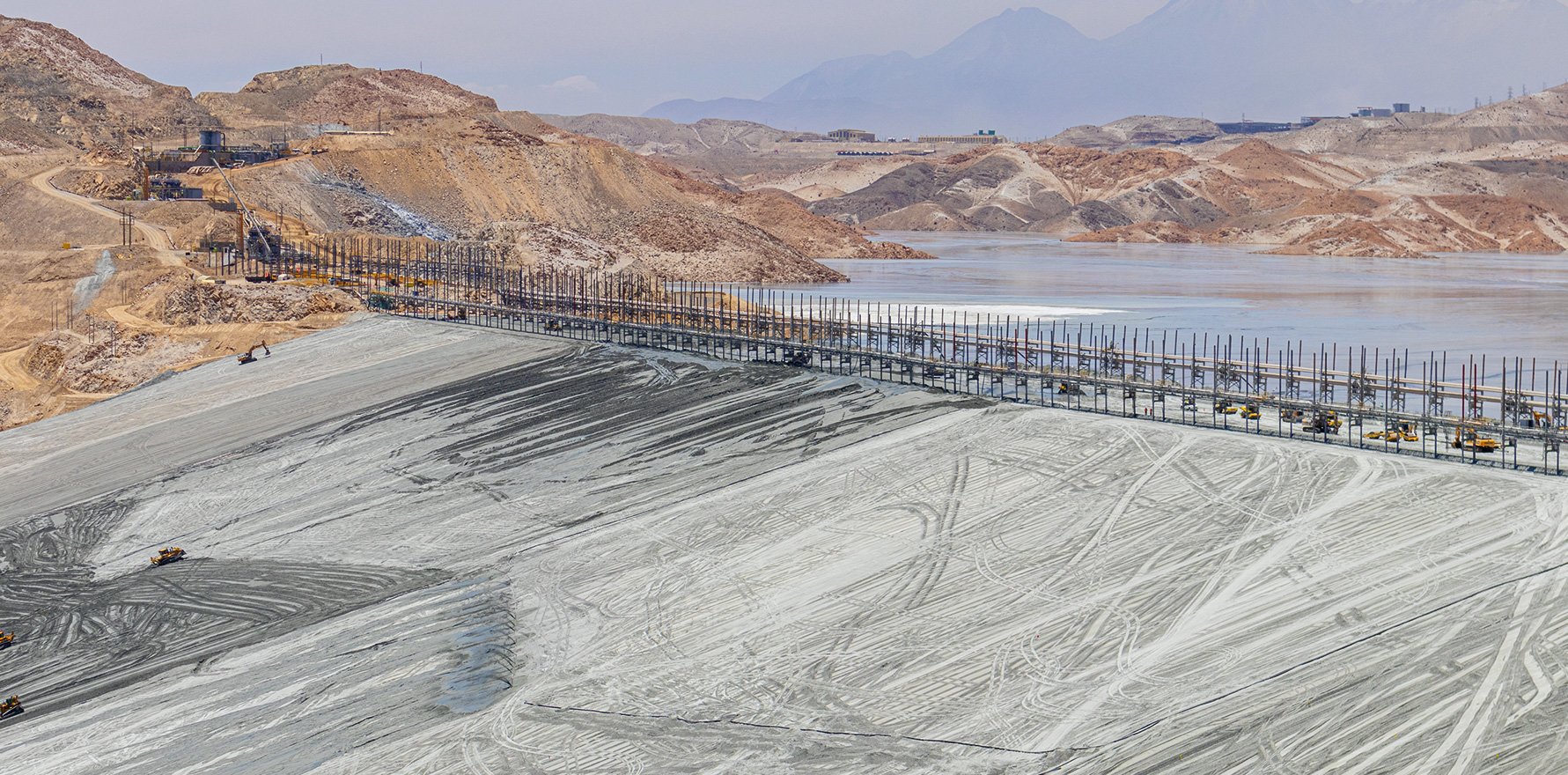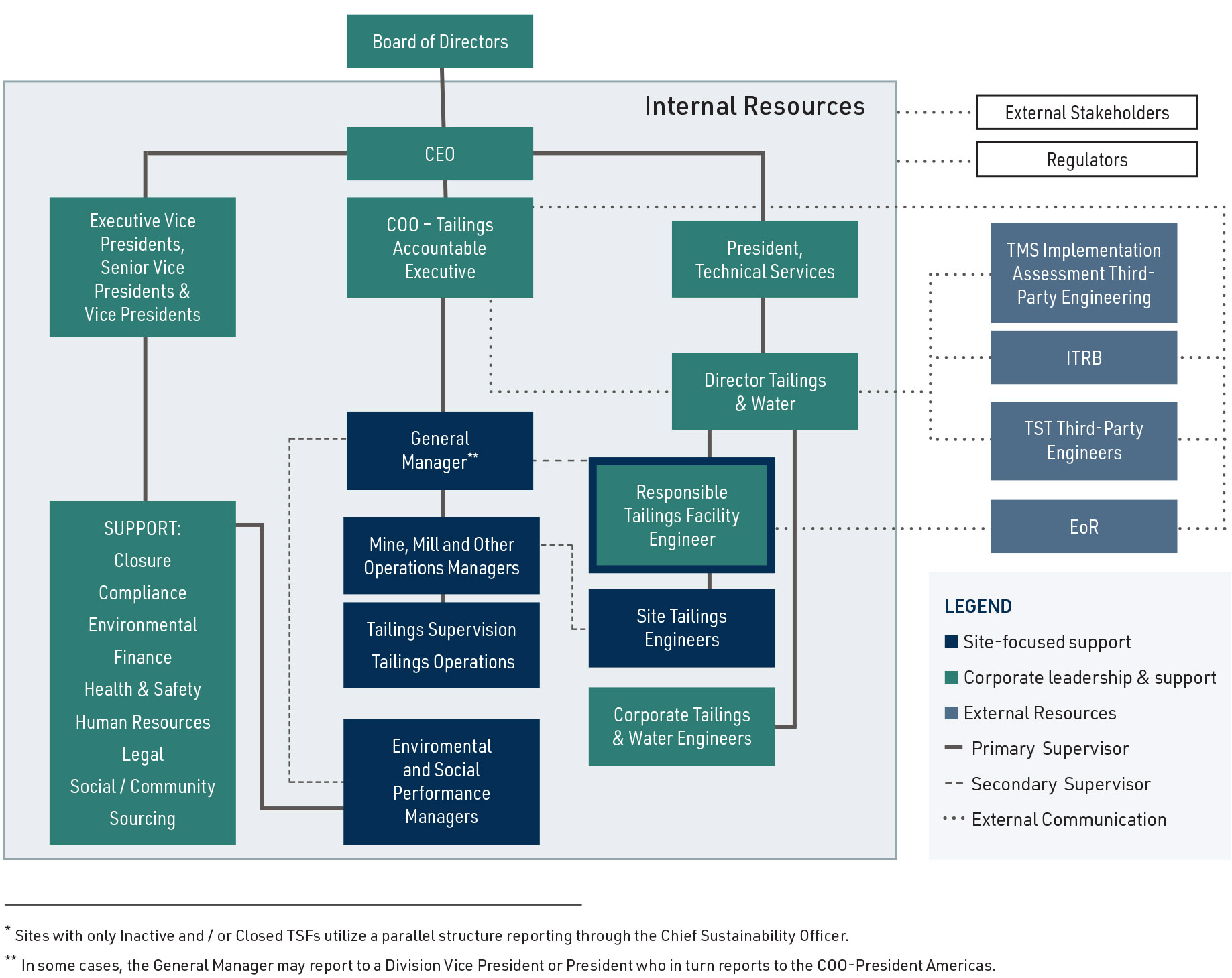Effective and responsible tailings management is essential for safe mining operations, protecting people and the environment, and maintaining our social license to operate. We have comprehensive measures in place to help ensure our TSFs are designed, built, operated, closed, and monitored/maintained to minimize risk to our workforce, communities, and the environment.
WHY TAILINGS MANAGEMENT MATTERS

The health and safety of our workforce and host communities and the protection of the environment are fundamental to our extensive tailings management system (TMS) programs and approach. Our objective is to have zero fatalities, zero catastrophic failures and zero unplanned discharges from any of our TSFs.
Our Tailings Management Policy outlines our continued commitment to managing our tailings responsibly and effectively across our sites globally. This policy is designed to be implemented in conjunction with our Environmental, Human Rights and Social Performance policies and associated management systems.
OUR TAILINGS MANAGEMENT JOURNEY TO DATE
Freeport-McMoRan Inc. (FCX) established a Tailings Stewardship Program, which, over the last 20 years, has evolved into our comprehensive TMS. Our TMS, led by our expert team of tailings professionals, comprises specific programs to address the various aspects of TSFs – over all phases of the TSF lifecycle – while promoting continuous improvement. Through our TMS, we systematically analyze potential failure modes, then work to eliminate or mitigate them to minimize the risk of failure scenarios associated with our TSFs. The TMS incorporates applicable regulations and international best practices, including the integration of the Global Industry Standard on Tailings Management (Tailings Standard).
FCX has comprehensive measures in place to help ensure our TSFs are designed, built, operated, closed, and monitored/maintained to minimize risk to our workforce, communities, and the environment. The TMS comprises specific programs to address aspects of tailings planning, design, operation, maintenance, surveillance, and risk management over the TSF lifecycle. Although there is some overlap among the categories, our safeguards generally fall within four categories: 1) Engineering practices and safe designs 2) Adherence to construction and operational parameters through monitoring and use of technology 3) multi-tiered oversight and robust management of change and 4) Adherence to practices grounded in continuous improvement and learning from past experiences, including industry failures and best practices.
IMPLEMENTATION OF THE GLOBAL INDUSTRY STANDARD ON TAILINGS MANAGEMENT
In 2020, FCX supported development of and committed to working towards implementation of the Global Industry Standard on Tailings Management (Tailings Standard). The Tailings Standard was developed through an independent, multi-stakeholder process co-convened by the ICMM, United Nations Environment Programme, and the Principles for Responsible Investment. The Tailings Standard requires mining operators to take responsibility and prioritize the safety of TSFs through all phases of the facility’s lifecycle and strives for zero harm to people and the environment. The Tailings Standard includes 77 requirements across six key areas – design, construction, operation and monitoring of tailings facilities, management and governance, use of integrated multi-disciplinary knowledge, engaging with affected stakeholders, emergency response and long-term recovery, and public disclosure. FCX also played a leadership role in the development of the Conformance Protocols for the Tailings Standard and the ICMM Tailings Management Good Practice Guide.
We have integrated requirements of the Tailings Standard within our existing systems. For example, we enhanced our multi-disciplinary collaboration and integration of our management systems. We also refined our risk assessment process and conducted gap-filling studies across our TSFs to enhance the knowledge base used for our risk assessments.
FCX remains committed to the implementation of the Tailings Standard at applicable tailings storage facilities. Conformance has been achieved for TSFs at all applicable sites, including independent verification, with the exception of one discontinued operation where the independent verification report is pending. We also completed the review of our closed TSFs to determine which are deemed Safely Closed, as defined by the Tailings Standard. For a TSF to be designated as Safely Closed, FCX conducted an internal review, including a suite of detailed technical evaluations, which were supported by multidisciplinary team risk assessments. The designation was approved by the appropriate Accountable Executive (AE) and confirmed by the Independent Tailings Review Board (ITRB).
CONSEQUENCE CLASSIFICATIONS FOR OUR TAILINGS STORAGE FACILTIES
To determine the consequence classification for our TSFs, FCX conducts risk assessments. TSF risk assessments include risk identification, analysis and evaluation used to determine which measures are, or should be, in place to eliminate or minimize risk. Outcomes also inform TSF consequence classification.
The risk assessment focuses on potential physical failures of each TSF, which may include instability, slope failures, excessive slope erosion, overtopping of the impoundment and internal erosion. For the purposes of the assessment, FCX defines a TSF failure as the unintended loss of the structural containment where the tailings and water released could be impactful.
During the risk assessment process, multidisciplinary teams use available information such as TSF-specific detailed data and engineering analysis, expertise from team members, case histories, and regulatory data to identify how a TSF failure may occur and what factors exist that make the potentially credible failure mode more or less likely (considering the site-specific knowledge base, existing robust controls and uncertainties), and ultimately determine which are credible failure scenarios. A credible failure scenario comprises of a credible failure mode (CFM) and an associated consequence that is technically feasible considering analysis and expert opinion on a minimum threshold of possibility of occurrence during a structured analysis process.
The credible failure scenarios are then used to create a TSF consequence classification, as defined by the Tailings Standard. The TSF consequence classification is based on downstream conditions and potential impacts of CFMs, including incremental losses to Population at Risk, potential loss of life, environmental impacts, health / social / cultural impacts, and infrastructure and economic impacts.
FCX integrates our value of safety into our tailings programs by taking a conservative approach to consequence classification (see diagram below for additional detail). Our definitions for consequence classification align with the Tailings Standard except as outlined below:
- If there is one or more permanent Population at Risk – including the public, employees, or contractors – the CFM is classified as Extreme. In contrast, the Tailings Standard considers Population at Risk greater than 1,000 people to be classified as Extreme.
- If there is no permanent Population at Risk, but there is a transient Population at Risk, the minimum consequence classification is Significant.
- Other metrics (as defined in the Tailings Standard for environmental and health; social and culture; and infrastructure and economics) help further determine the consequence classification.
Regardless of the TSF consequence classification, all of FCX’s operating TSFs and Development TSFs are designed, analyzed and operated using Extreme loading criteria. Design criteria for Inactive, Closed, and Safely Closed TSFs are informed by the Extreme loading criteria and assigned using the As Low As Reasonably Practicable (ALARP) principle.
In accordance with the Tailings Standard, FCX’s updated consequence classification approach incorporates each TSF’s detailed information and analyses that have been enhanced over the past few years to reduce uncertainties and incorporate expert opinions on thresholds for CFMs.
Information about site-specific classifications can be found in FCX’s disclosures.
About Tailings and Tailings Storage Facilities
Overview of Tailings and Tailings Storage Facilities
Tailings are the finely ground rock particles left after copper or other minerals have been processed and extracted from the mined ore. Tailings cannot be put back into their original form, so TSFs are necessary to secure them safely and responsibly. A TSF is a structure made of one or more embankments, that provide a secure environment to keep tailings indefinitely.
TSFs have two main purposes:
- To indefinitely store the tailings safely and responsibly
- To reclaim water that can be reused in plant processing facilities
Designing and Constructing Tailings Storage Facilities
TSFs are uniquely engineered structures, with embankments often constructed from the tailings material itself. The process to design and build TSFs is a robust one that considers various factors and requires engagement with numerous stakeholders, partners, independent reviewers, and regulatory agencies. Factors include site conditions such as geology, topography, climate, hydrology, hydrogeology, seismicity, and the material being used for construction – in addition to social, community, and environmental factors. These factors are evaluated to determine the most appropriate site before undergoing a rigorous permitting process. There is no “one size fits all” design approach.
Our goal is to safely contain the tailings under any and all circumstances and throughout a TSF’s entire lifecycle; we take this responsibility seriously and strive to ensure all our TSFs meet or exceed governing standards. Freeport has a demonstrated track record of developing and constructing resilient TSFs, considering site-specific conditions to help ensure the safety and longevity of each facility.
There are three types of embankments – upstream, centerline, and downstream. FCX owns and operates TSFs with all three embankment types, though the majority have upstream embankments.
Upstream Tailings Storage Facilities
Upstream construction begins with an initial embankment, which is constructed at the toe of the facility area and then discharged to form a tailings beach and structural zone. The deposited tailings drain and compact, becoming the foundation for subsequent levels as new tailings are added and the embankment is raised. Upstream TSFs must be raised slowly over time to allow the solid tailings to dry and consolidate enough to support a new level of the embankment.
Centerline Tailings Storage Facilities
In centerline construction, the facility is raised vertically from the initial embankment. The embankment crest remains fixed relative to upstream and downstream directions as the facility is sequentially raised. Unlike the upstream TSFs, the wall of a centerline TSF does not use beached tailings to support its foundation.
Downstream Tailings Storage Facilities
Downstream designs start with an initial embankment similar to the other two construction methods. Tailings are then discharged into the facility and as the embankment is raised, each new wall is constructed and supported on top of the downstream slope of the previous section, so the crest moves downstream with each raise.
To learn more, please see our 2022 ANNUAL REPORT ON SUSTAINABILITY
Responsible Management of Tailings Storage Facilities
Freeport-McMoRan’s Commitment to Safety
The health and safety of our workforce and communities, and the protection of the environment are fundamental to our extensive tailings management program and approach. Our objective is to have zero fatalities, zero catastrophic failures, and zero unplanned discharges from any of our TSFs.
Our Tailings Management System
The TMS comprises specific programs to address aspects of tailings planning, design, operation, maintenance, surveillance, and risk management over the TSF lifecycle. Although there is some overlap among the categories, our safeguards generally fall within four categories:




Governance
p>FCX’s programs and safeguards are effectively implemented through the promotion of open and ongoing communication throughout our organization and with a bias for action.
We remain focused on the safe execution of our TMS by maintaining robust, multi-tiered governance of our tailings programs, which involves appropriately qualified personnel with clearly defined roles, responsibilities and accountabilities. There are multiple layers of assurance we apply to all TSFs: site-level implementation, functional accountability, third-party review, and board and executive leadership oversight.
Key Roles in Governance Structure
Site-level Implementation
- Site Tailings Management, Engineers, and Operators: Internal team that implements the management program and regularly monitors, identifies, and addresses potential risks.
- Responsible Tailings Facility Engineer (RTFE): Internal engineer appointed by the Accountable Executive responsible for the integrity of assigned TSFs. The RTFE provides technical expertise, manages risk, and liaises with the EoR. Corporate discipline experts provide regular support to RTFEs. ;
- Engineer of Record (EoR): External engineer who provides expert design and engineering analysis, technical support, inspection, review, and guidance to support an RTFE in achieving design intent of their assigned TSF.
Functional Accountability and Responsibilities
- Accountable Executive (AE): Chief Operating Officer (sites with active tailings operations) or Chief Sustainability Officer (sites without active tailings operations) who reports to the FCX Chief Executive Officer and is accountable for the safe management of TSFs and for minimizing the social and environmental consequences of any TSF failure.
- Tailings and Water Director: Oversees RTFE activities and has delegated responsibilities from the AE for engaging with and reviewing the site-implementation of TMS activities.
Third-Party Review
- Independent Tailings Review Board (ITRB): Third-party, internationally known expert panels who provide independent opinions and guidance on the physical integrity, safety, and performance of TSFs and have access to corporate senior leadership. Members have decades of experience in applicable disciplines.
- Tailings Stewardship Team (TST): Third-party professional engineers who have not been directly involved with the design or operation of the TSFs and internal experts who inspect all TSFs, review documents and monitoring data, identify potential deficiencies, and recommend corrective actions.
- Tailings Management System (TMS) Implementation Assessment Consultant: An external assessor with sufficient knowledge and understanding of the TMS to assess the efficacy of the TMS applied at a site-specific level, including key tasks, roles and responsibilities, and associated governance structure to support proper management and operation of the TSFs, and structural integrity.
Board and Executive Leadership Oversight
- Corporate Senior Leadership: Executive leadership that participates in major decisions related to the tailings management program, including allocation of resources for TSF-related operations, initiatives, and projects.
- Board of Directors: Corporate governing body firmly committed to providing active oversight and, with the Corporate Senior Leadership, the necessary financial and technical resources to maintain the safety and integrity of our tailings facilities globally, with a focus on risk management and continuous improvement. The AE regularly reports to the Corporate Responsibility Committee of the Board of Directors on matters related to the tailings management, including implementation of the Tailings Standard.
Risk Informed Decision Making
Risk informed decision making (RIDM) is a critical and integral part of how we design, build, and operate our TSFs. By understanding and assessing the risks associated with a TSF, we can more effectively protect our people, host communities, and the environment.
RIDM is informed by the Tailings Standard and consists of three primary elements:

A risk assessment for a TSF entails identifying, analyzing, and evaluating risks to determine both their potential consequences and likelihood, enables prioritization, and helps determine risk management options.
We assess what is needed to keep TSFs running safely as well as how to adapt to future conditions across all phases of the lifecycle, including evaluating changes in seismicity, climate, material characterization, ore variability, and processing throughput, as well as land use and the needs of neighboring communities.
The risk assessment also considers credible failure scenarios across all phases of the TSF lifecycle and identifies ways to minimize the related risks, with an integrated team regularly conducting detailed technical, operational, social, and environmental analyses.

Using the learnings from the risk assessment, our expert teams use engineering and operational controls to prevent, minimize and/or mitigate risks. These controls include an ongoing focus on quality engineering design, construction, and operating discipline. Additionally, part of mitigating risk is openly engaging with our host communities and external authorities to maintain a shared state of readiness through robust emergency preparedness and response planning.

Risks and controls are reviewed periodically, including where there are high-potential events or changes in the external environment, to evaluate performance. In addition to our site engineers and operators, and our Engineer of Record(s), our Tailings Stewardship Team, which comprises third-party engineers and internal experts, physically inspects all our TSFs and reviews associated documents and monitoring data. Through this work, the team recommends actions to reinforce the safety of our TSFs. In addition, our Independent Tailings Review Board provides technical guidance on the physical integrity, safety and performance of our TSFs and associated management systems.
These three processes are underpinned by a culture of transparency, collaboration, and meaningful dialogue with the primary goal of fostering mutual understanding, trust, and cooperation.
To learn more, please see our Tailings Management Policy
Our Disclosures
FCX is committed to transparency by ensuring relevant information regarding TSFs at our operations is readily available through public disclosures and active engagement with stakeholders.
We publish and regularly update information on TSF management, implementation of our tailings governance framework, and our policies, standards and approaches to the planning, design, construction, operation, monitoring, maintenance, closure and post-closure of tailings facilities in alignment with the Tailings Standard.
Monitoring our TSFs is an ongoing process and disclosures will be updated as needed.
| FCX Operation/Site | Disclosure Report | Independent Verification Summary |
|---|---|---|
| Morenci 1 | ||
| Bagdad 2 | PDF |
PDF (Sycamore TSF) PDF ( Bagdad TSFs) |
| Cerro Verde 2 | ||
| Chino 2 | ||
| Climax 2 | ||
| Henderson 2 | ||
| Sierrita 2 | ||
| Bruce2 | Pending Receipt3 |
(1) Certain tailings storage facilities at this operation have Extreme or Very High consequence classifications per the Tailings Standard. Important safety information for neighbors and community can be found here: Morenci: A Guide To Tailings Storage Facilities.
(2) Certain tailings storage facilities at these operations have either High, Significant or Low consequence classifications per the Tailings Standard.
(3) Freeport completed a full evidence-based self-assessment for the Bruce TSFs with multi-level internal reviews. In summary, Bruce TSFs meet the applicable requirements in the Tailings Standard and are expected to achieve safe closure through a multi-year action plan. An independent verification of Tailings Standard implementation has been conducted, and the report is pending.
Note: Information on all FCX tailings storage facilities, including those deemed Safely Closed, can be found here: Site Specific Tailings Management.
To learn more, please see our 2024 ANNUAL REPORT ON SUSTAINABILITY
 BACK TO TAILINGS MANAGEMENT PROGRAM > AMERICAS
BACK TO TAILINGS MANAGEMENT PROGRAM > AMERICAS










